
Hindu and Muslim weddings are some of the most beautiful events in the world. Particularly those that are steeped in tradition and elaborately decorated with colors, flowers, and jewels. However, not all weddings in these two faiths are the same.
Wedding ceremonies in Hindu and Muslim culture have many similarities but also many differences. The influences on various couples and their wedding traditions stem from a variety of things. Some of these influences include:
- The region in which the couple resides
- The region where the couple was raised
- Traditions of the individual families
- Religious beliefs and traditions
- The affluence of the families
Muslim weddings, in particular, will vary greatly within their own faith. Some follow Islamic traditions very closely, while others have adopted some of the cross-cultural elements of Indian weddings.
Regardless of how closely the two faiths interact with and live in proximity to one another, there remain lots of differences between their wedding practices. Here, we will discuss some of those differences.
The Purpose of Marriage
Let’s start by discussing the reason that people get married in Hindu and Islamic faiths. The purpose of marriage between the two faiths is very different.
The purpose of a Hindu marriage is to seek Dharma (truth) or the “right way of living.” It is believed that marriage is a union between a man and a woman that allows them to seek not only Dharma but also arth (meaning) and kama (physical desires). The couple should conceive a son then to carry on the family name and traditions.
A Muslim marriage is also known as Nikah, or a binding legal contract for sexual appetite and procreation. The purpose of marriage in the Islamic faith is to have children and build a family to preserve and carry on the faith. A Muslim family is expected to be productive and add value to society as a whole.
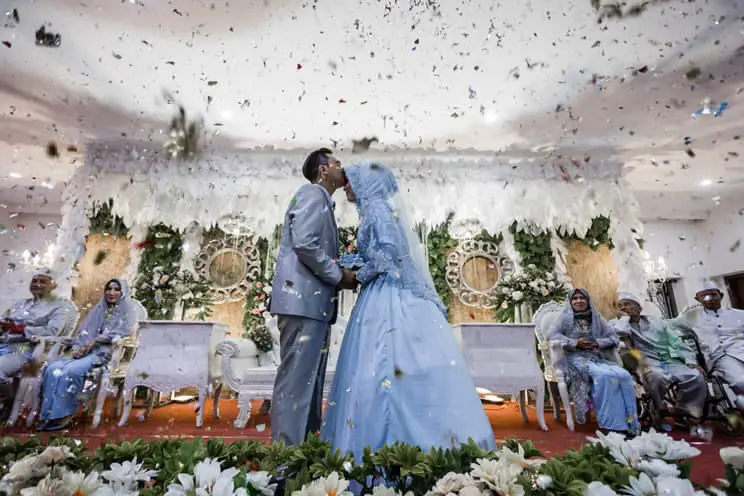
Events Leading up to the Wedding
Hindu and Muslim weddings also vary in the events leading up to the wedding. Hindu weddings often have several days of ceremonies and festivities before the wedding day. Most Muslim weddings have only 2-3 days of celebration, leading up to the main event.
In both religions, there is typically a party the night before the wedding and then various things that take place on the actual day of the wedding ceremony. The spiritualism of the different ceremonies varies greatly, though. Many couples have the autonomy to pick and choose which events and ceremonies they want to host, while other couples follow their families’ wishes.
Hindu Wedding Events
Hindu weddings and the ceremonies leading up to them can vary greatly based on the region in India where the couple lives or was raised. There is no standard for exactly what should and should not be included. Some regions are much more traditional than others and have more spiritual elements rather than social ones.
For example, a couple might choose to have the following ceremonies or celebrations leading up to their wedding day, amongst others:
Sangeet – Although the word “sangeet” means music, it can also be used in the context of a wedding event. In this case, it refers to a party that is thrown to allow time for the families of the bride and groom to bond with one another. The sangeet is often held on the night before the wedding.
This party not only celebrates the union of the bride and groom but also of the families. It typically includes music, dance performances, food, henna, and more.
Haldi Ceremony – This ritual holy bath is a tradition that happens on the morning of the wedding. During this ceremony, turmeric (Haldi) is mixed with oil and water. The blend is then rubbed onto the skin of the bride and groom in their separate quarters (i.e., this ceremony is not traditionally performed with the two together).
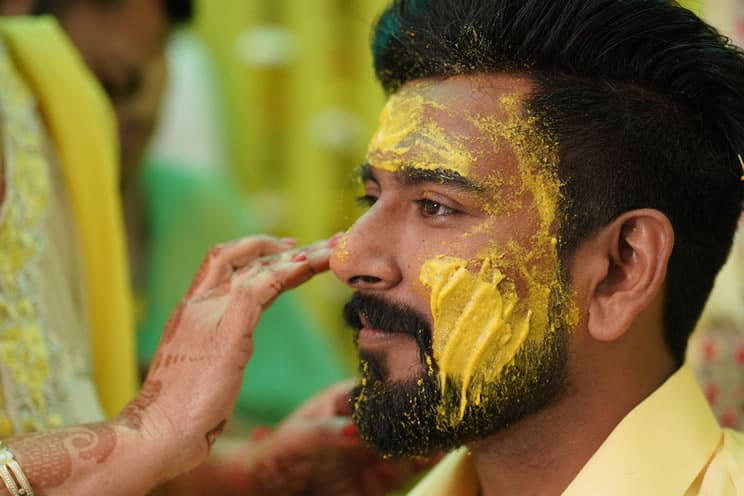
The mixture that is applied to their skin is believed to bring blessings to the couple before the wedding. The color of the turmeric also gives their skin a beautiful glow!
Choora Ceremony – Popular in Punjabi (northern India), this ceremony is usually held the day before, or the day of the wedding. It includes a cluster of bangles that are gifted to the bride by her maternal Uncle and Aunt. They were traditionally made of ivory, but many are now made of plastic.
In older traditions, the bride would wear the choora for a full year after marriage, unless she became pregnant. However, in more modern times, the bride will wear them for 40 days. Since they were made of delicate materials, the bride could abstain from heavy housework for the 40 days, which signified a type of “honeymoon” for her.
Baraat – The groom’s procession is called the baraat. During this procession, the groom goes to visit the bride’s home. Traditionally, he would ride an animal such as a horse or even an elephant. It has evolved over time to be a car or other vehicle.
When the baraat arrives at the home of the bride’s family, he is often met with music and dance. The bride’s family will adorn him with a flower lei. He is then allowed into the home to find his bride.
Muslim Wedding Events
Muslim weddings also have a variety of events and ceremonies leading up to the actual day of the wedding. Many of these events are focused on the two families becoming one and spending time together.
Proposal – Depending on how conservative the family, this event can look very different. Traditionally, the groom’s parents and elders would go to the home of the bride-to-be and ask her family for her hand in marriage. However, it is now common for the groom to do so if his family allows it.
Some proposals include a gift of jewelry or a small amount of money. This signifies their commitment to the marriage. They might also recite some passages from the Quran during this event.
Mangni – This is a celebration of the engagement during which the bride and groom actually exchange rings. The families gather together and bring gifts for one another. These gifts might include sweets, fruits, jewels, and sometimes money.
This ceremony serves as a commitment from both families that they intend to go forward with the marriage. At this point, the couple is considered to be betrothed to one another and no longer single.
Mehndi or Henna – This is a skin decoration used primarily on the Indian subcontinent, but also in some primarily Arabic countries. This was traditionally an all-female event a few nights before the wedding. However, it is now sometimes a mixture of both men and women from both the bride and groom’s side.
During this party, the henna is applied to the hands and feet of the bride-to-be. During this process, traditional songs are played, along with the dholki or drum. In some families, even close friends and family have the henna applied to their skin, as well.
Attire
Make no mistake that fashion is a huge part of the wedding festivities in both faiths. Whether the bride and groom opt for more conservative attire or something else, it will be lavish! And the guests are expected to follow suit.
As with a wedding in any culture or faith, Hindu and Muslim weddings have traditional attire that is worn by the bride and groom. It can vary greatly based on regional differences. There is also an expectation placed on the guests of the wedding for appropriate attire.
In western cultures, it is considered rude as a wedding guest to dress better than the bride. But in Hindu and Muslim culture, married women who attend a wedding will wear highly ornate clothing and lots of gold. This helps to establish their place in society.
Hindu Wedding Attire
Hindu weddings are extremely colorful, often with elaborate clothing and adornments. If the couple chooses to have multiple ceremonies or celebrations in the days leading up to the wedding, there is typically different clothing for each day.
Hindu brides traditionally choose between a wedding sari or a lehenga. This choice is generally dictated by the region in which she lives. Red and gold are the most traditional colors for the bride to wear.
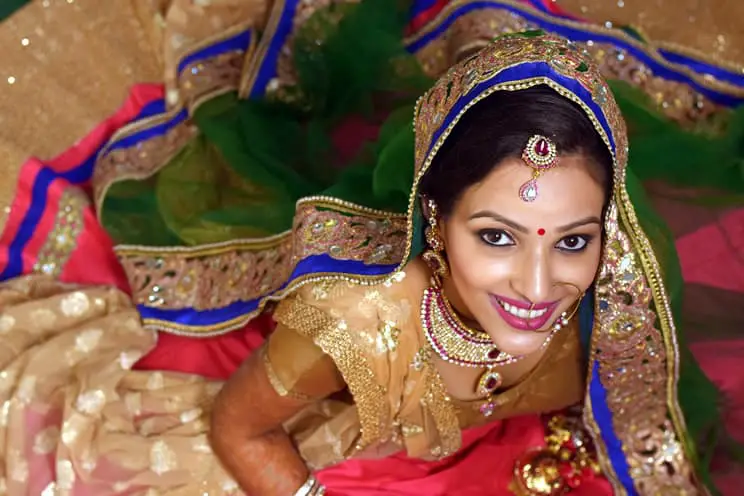
The bride is often adorned with choora (bangles), lots of gold jewelry, and a veil that does not cover her face. She will also traditionally have the henna patterns adorning her palms, forearms, legs, and feet.
Hindu grooms tend to be more regal and simple in their attire, often wearing white. They generally opt for a traditional coat called a Sherwani. His coat can be made of cotton, silk, or other materials. It is often adorned with jewels or other embellishments at the collar.
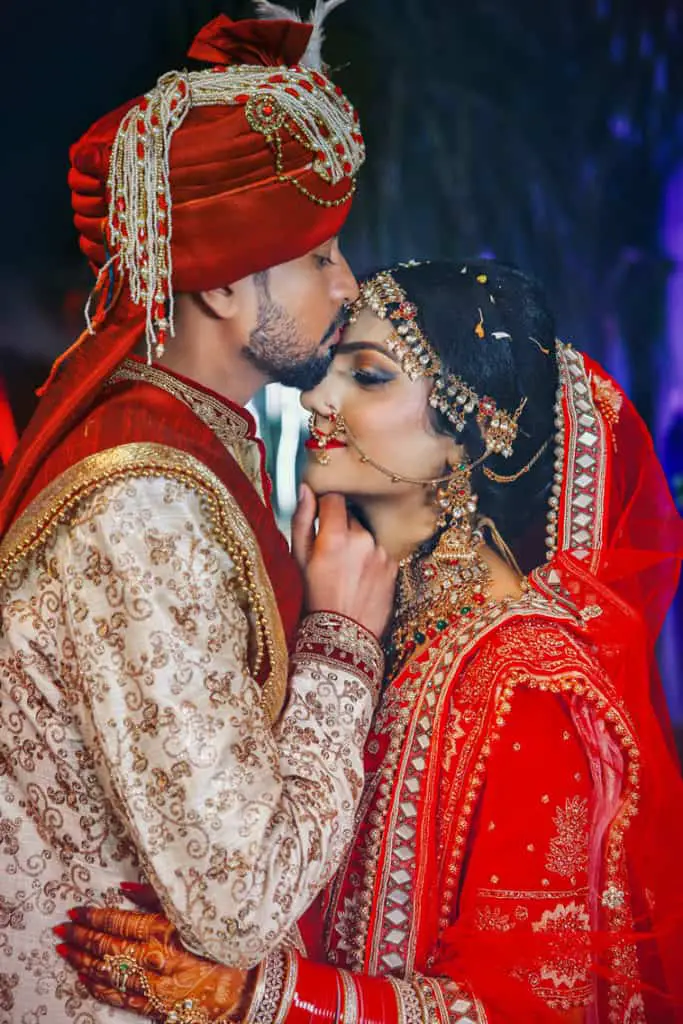
The groom may also choose to have henna patterns on his hands and feet. They are often more muted than those of the bride.
Hindu wedding guests are generally expected to wear traditional Indian clothing. This can be in the form of a colorful sari, a traditional pantsuit, or a lehenga. Ladies may also be expected to cover their hair during the religious portion of the ceremony.
Male guests can opt for a simple pantsuit or something more traditional. If opting for traditional attire, a man might choose a long tunic with pants underneath.
Wedding guests should definitely opt for colors and not white. While white is a traditional wedding color in many other cultures, it is associated with funerals in the Hindu culture. For this reason, guests should opt for colorful clothing.
Muslim Wedding Attire
Muslim weddings can be extremely colorful and vibrant, much like Hindu weddings, or they can be very simple and understated. It is typically dependent upon the traditions of the family and region in which they live. Muslims living in India have greater tendencies towards elaborate colors, while those in primarily Arabic countries tend to be more muted.
Muslim Brides often opt for the muted elegance of white or off-white. Depending on the beliefs and traditions of the family, they typically wear a hijab or headscarf to cover their hair. The dress and hijab can be highly decorated or very simple.
In contrast, some Muslim brides will opt for vibrant colors and ornate jewelry. They will typically also wear a hijab or headscarf. These brides are generally in or near the Indian sub-continent and adopt some of the cross-cultural traditions and colors.
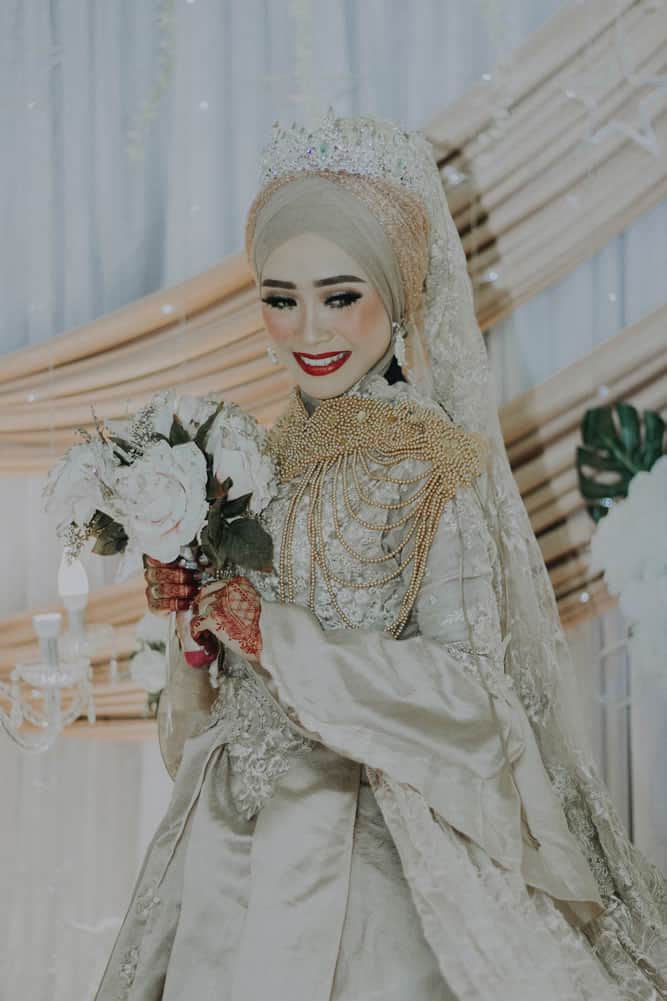
Muslim weddings are usually more conservative than Hindu ones. Very few Muslim brides opt for the lehenga for her gown because it exposes the midriff. It is not necessarily forbidden in Muslim traditions but is definitely less conservative than a sari.
Muslim Grooms typically wear Kurta Pajama. There are not many restrictions in terms of color, with the exception of black. Since black is worn for funerals, most Muslim grooms do not wear it for their wedding. As with the bride, many grooms will opt for very vibrant colors if they live in a region with those cultural influences.
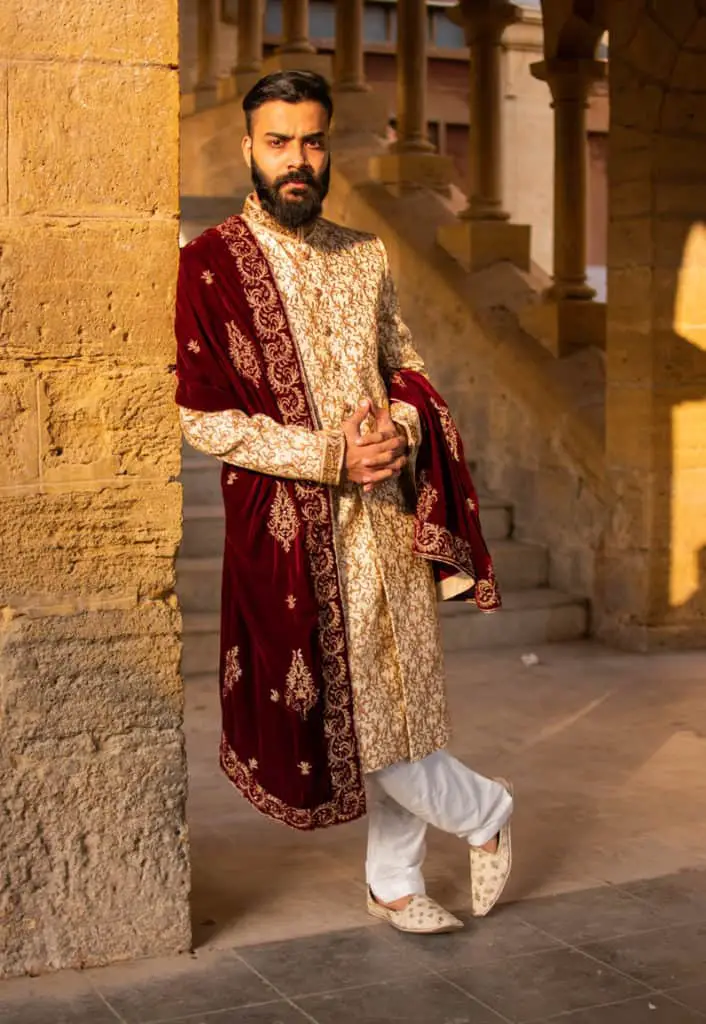
Modern Muslims have begun to opt for a suit with a sherwani, which is basically long pants with an embellished overcoat on top. The coat drapes almost to the knees and is usually a contrasting color to the pants. The embellishment is created by intricate embroidery and even jewels.
If the groom is Sunni or Shia, he may also wear a headpiece called a taqiyah. This is a hat that is sometimes worn as-is and sometimes wrapped in a turban.
Muslim wedding guests are typically asked to be as conservative in their dress as possible. Both genders are expected to cover their skin, preferably from their neck to their ankles. Although it is generally assumed that women are expected to cover more than men, both genders should be respectful by covering as much as possible.
Bare arms should never be exposed at a Muslim wedding, inside a mosque, or at any of the wedding events. Women are also expected to cover their hair while inside the mosque out of respect for the faith and traditions.
Main Event of Ceremony
Both faiths have many ceremonies and traditions that take place leading up to the wedding. But the most important event in both faiths is the actual wedding ceremony.
During the ceremony in both faiths, the bride and groom are joined in union as one. This is the final dedication of the two to one another. It also symbolizes the fusing of the two families together.
Vivah
The Vivah is the name for the Hindu wedding ceremony. While the wedding, including all parties, rituals, and festivities, is called the Vivaha, the actual wedding ceremony is the Vivah.
This ceremony can include a variety of elements, but generally includes at least these three:
- Kanyadana – The father giving his daughter away
- Panigrahana – A ritual whereby the groom takes the bride’s hand, in the presence of fire, to symbolize the union
- Saptapadi – The Seven Steps. This is the critical ritual involved in the Hindu wedding ceremony. It is performed in the presence of fire and includes the exchange of seven vows between the bride and groom. It is often performed in Sanskrit or in the language of the couple.
Nikah
This is a very simple marriage ceremony for Muslim couples. In the Nikah, the bride doesn’t have to be present if she chooses not to. She can send two witnesses to write the contractual agreement. The Nikah is simply the agreement that binds the husband and wife together as one.
In most cases, both the bride and groom are present, along with their chosen witnesses and an Imam to perform the ceremony. The Nikah requires three things:
- Bride and groom
- Witness
- Mahr, or gift that the groom gives to the bride
Since the Nikah is a private, family affair, there is not much to tell about various rituals performed. In general, the Imam reads from the Quran, and the couple agrees to uphold the marriage. The families then move on to celebrate at the reception, which is called the Valima.
Conclusion
There are many similarities between Hindu and Muslim weddings. They are rich in tradition and include many members of the bride and grooms’ families. They include lots of religious and spiritual elements that are meant to honor the faith and the families involved.
But the many differences between them are not to be ignored. If you are planning to attend a wedding for a couple in one of these faiths, you should take note of the differences. Being appropriately dressed and understanding what each party or ceremony is for will help you enjoy the occasion.
If you are planning a wedding in one of these faiths, hold on for a ride! Take the time to evaluate each and every detail so you can appropriately honor the values of your family and your faith. This is a beautiful time in the lives of both your family and your future spouses’ family, so enjoy it!
